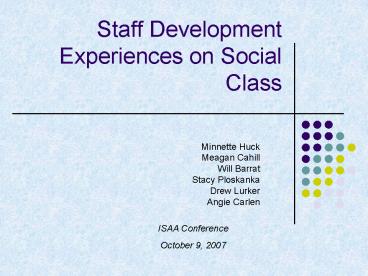Staff Development Experiences on Social Class - PowerPoint PPT Presentation
1 / 17
Title:
Staff Development Experiences on Social Class
Description:
Social Class Defined. Social class is a collection of sub-cultures arranged in a ... Students feel pressure to assimilate to upper-middle social class values. ... – PowerPoint PPT presentation
Number of Views:24
Avg rating:3.0/5.0
Title: Staff Development Experiences on Social Class
1
Staff Development Experiences on Social Class
- Minnette Huck
- Meagan Cahill
- Will Barrat
- Stacy Ploskanka
- Drew Lurker
- Angie Carlen
ISAA Conference October 9, 2007
2
Presentation Overview
- Definition of Social Class
- Current Campus Climate
- Importance of Social Class
- Staff Development Activities
- Understand Your Campus
3
Social Class Defined
- Social class is a collection of sub-cultures
arranged in a hierarchy or prestige. - Class is culture and a social construct.
- Hidden in plain sight.
- Socio-Economic Status plays a role in social
class through income, occupation and educational
attainment but much more lies beneath this
invisible diversity.
4
Beyond Your Bank Account
- Economic Capital
- Affluence
- Rich v. poor
- Cultural Capital
- Refinement and style
- Sophisticated v. Rednecks
- Social Capital
- Connections
- Connected v. Isolated
- Educational Capital
- Degree attainment
- 4.0s v. 2.0s
5
Current US Educational AttainmentChronicle
Almanac 2003-2004 Census data for adults over 25
in 2000
6
Current US Family IncomeUS Census data 2000
- 5 of US Families make more than 164,104
- 20 of US Families make more than 94,150
- 40 of US Families make more than 62,500
- 60 of US Families make more than 41,127
- 80 of US Families make more than 24,000
7
Current Campus Climate
- Current campus attitudes are driven by middle and
upper-middle class attitudes, values, and
behaviors. - College is a middle classing experience.
Students feel pressure to assimilate to
upper-middle social class values. - Young adults from high-income families are three
times as likely to attend college as those from
low-income families. - Measuring Up 2004 The State Report Card on Higher
Education, The National Center for Public Policy
and Higher Education.
8
Social class of origin andcollege graduation
- Family Income 1991 Graduation Rate
- Over 75,000 81.9
- 50,000-74,999 73.0
- 25,000-49,999 62.1
- Under 25,000 52.3
- 8 year graduation rates among 1992 12th graders
with bachelors degree goals who attended a 4
year institution. - NCES (2005) First Generation Students in Post
Secondary Education.
9
Why is Social Class Important?
- Too much of an invisible battle with not enough
visible support. - Everyone has one and everyone is affected by one.
- Low SES students are not graduating at as high of
a rate as those with a high SES. More services
and awareness is still needed.
10
Staff Development Activities
- The Line
- Product Identification
- Minnettes Thingy
11
Step Into Social Class
- An activity designed to help the participants
gain awareness of the vast range of social class
that exists within themselves and others. - Facilitate Activity
12
Social Class Knowledge Quiz
- An activity designed to help participants
understand what labels, brands and activities are
associated with each social class group. - Facilitate Activity
13
Campus Connections
- An interactive activity designed to help
participants experience different social class
standings and how it effects college life. - Explain activity
- Results from past activity experiences
- How to implement on your campus
14
Understanding Your Campus
- The first step is to understand your personal
social class standing and how it affects others - Need to understand campus is not a level playing
field. Some students have a steeper climb and
will need more assistance. - Students who feel pressure to assimilate to
upper-middle social class may experience
internalized conflict when moving between classes.
15
Conclusion
- Social class is an invisible dimension of
diversity. - Social class affects every person on every
college campus. - Students with lower social class face additional
pressures and need additional resources.
16
Questions?
17
Thank You!
- If you would like additional information on items
we have discussed, please contact - ?































